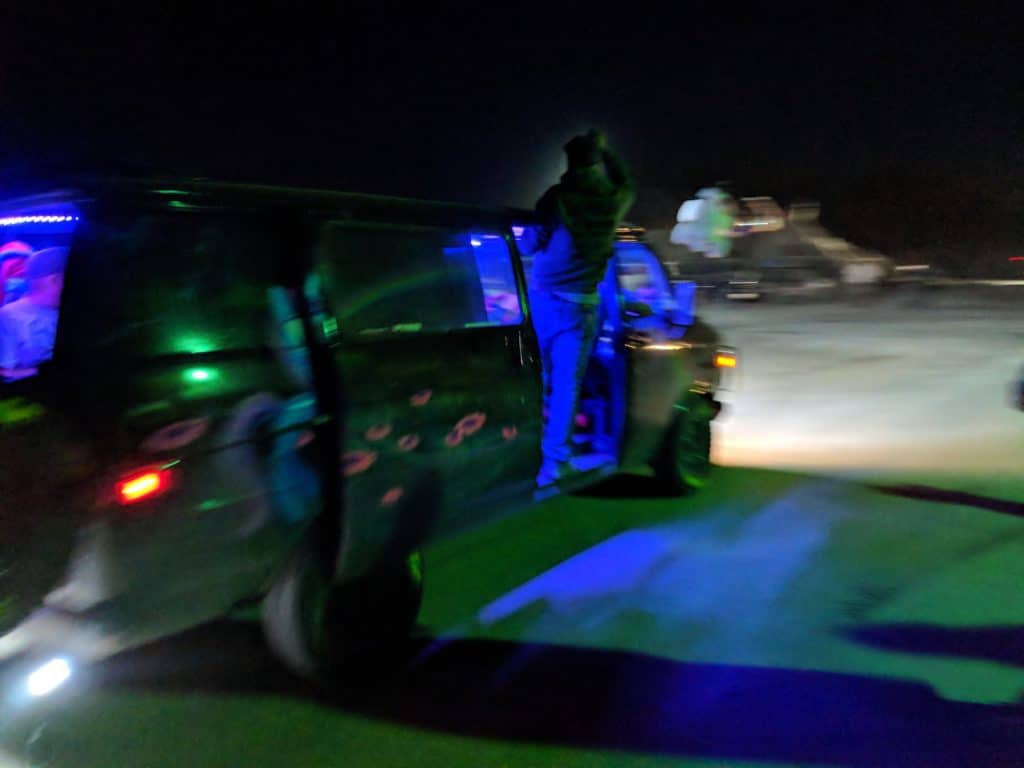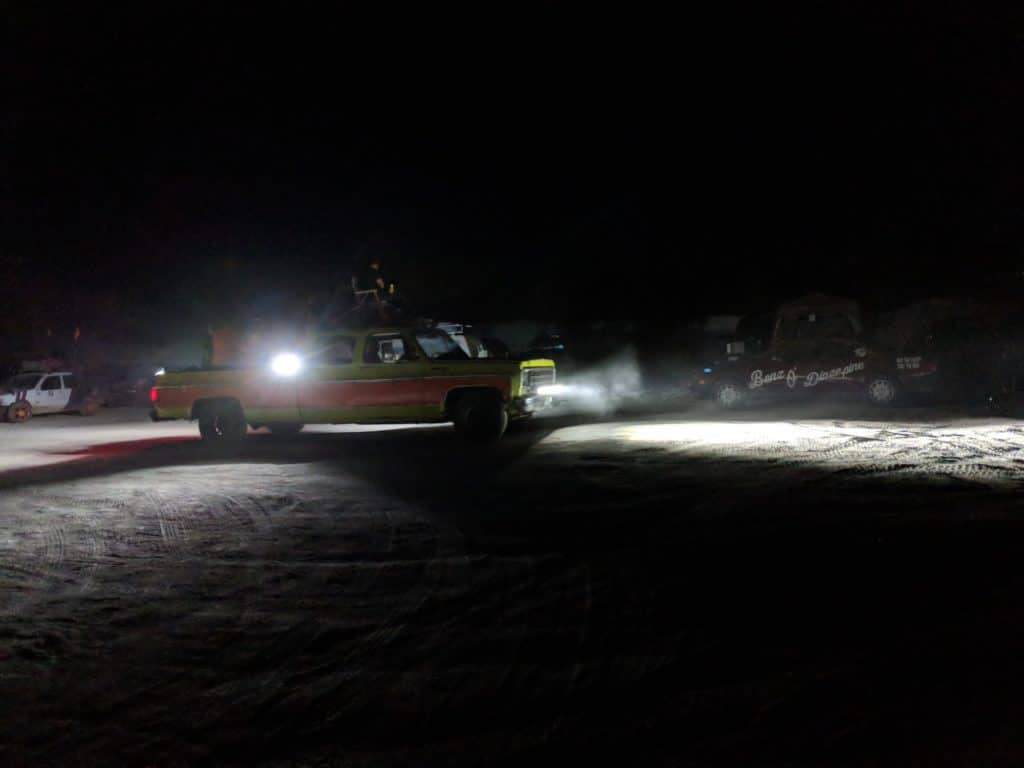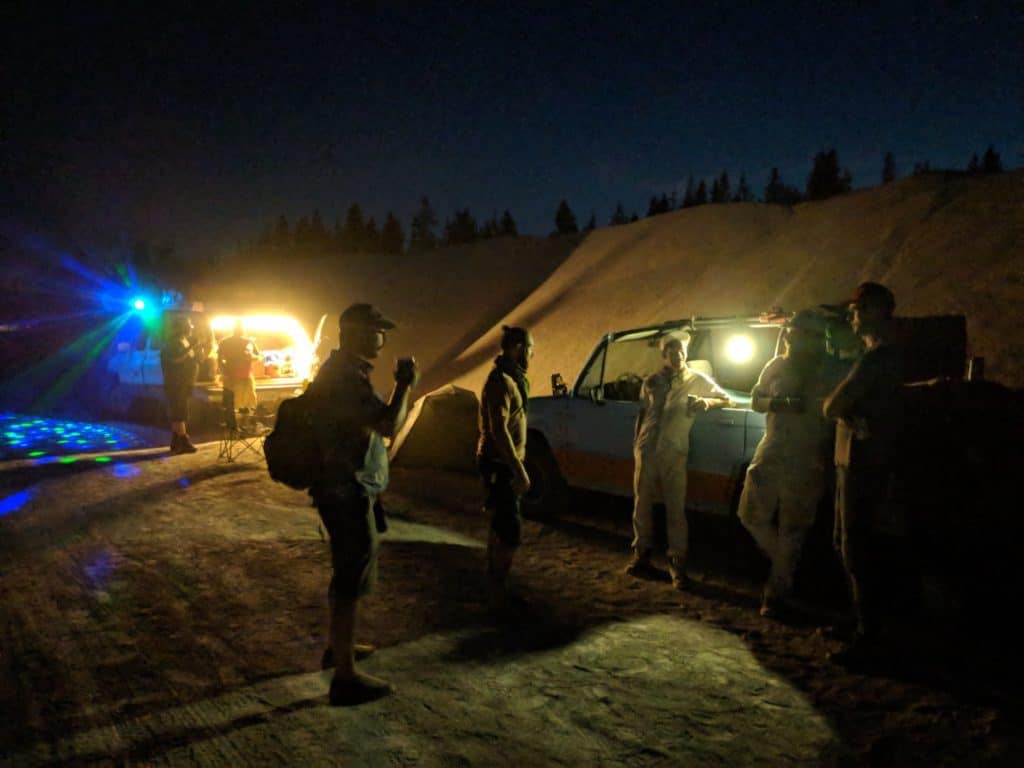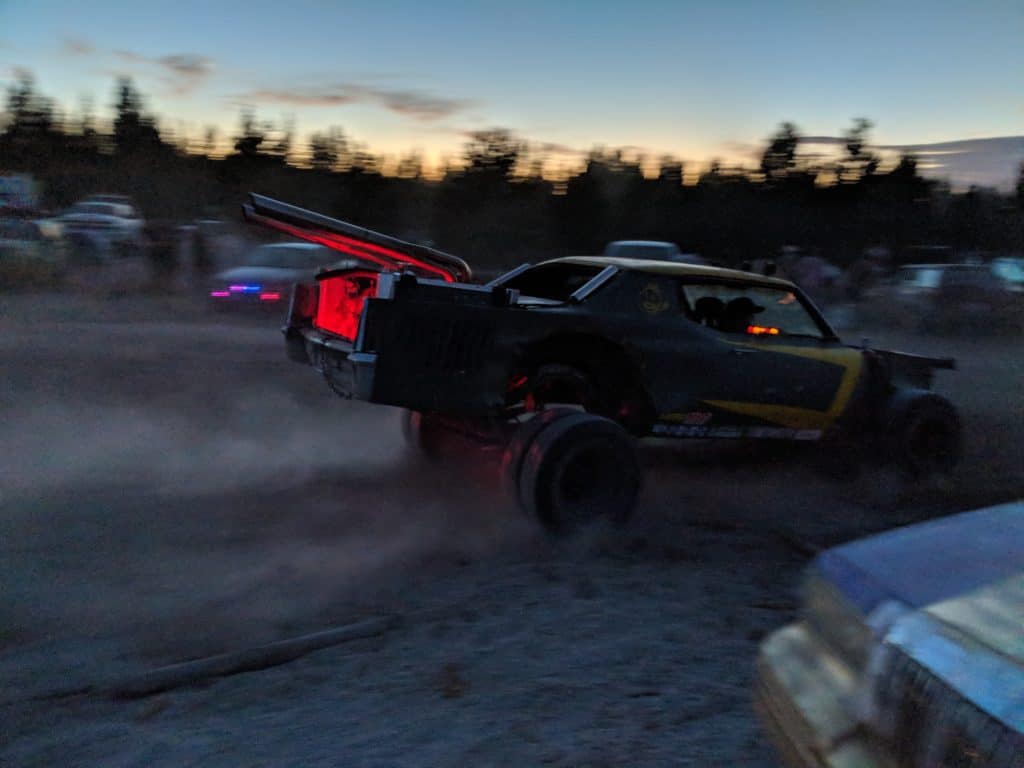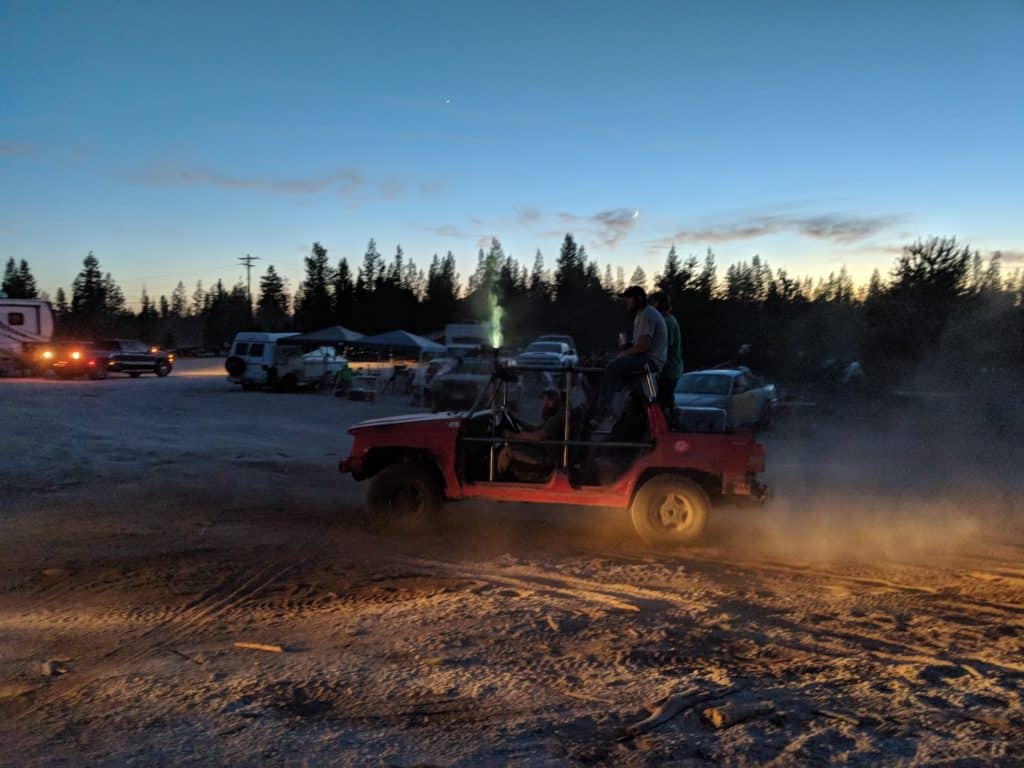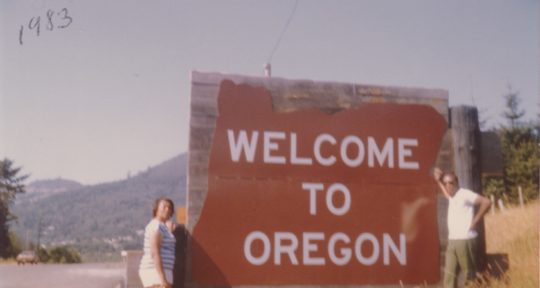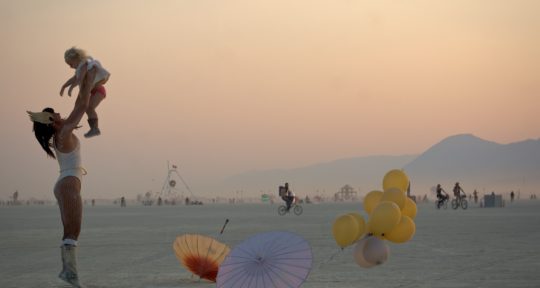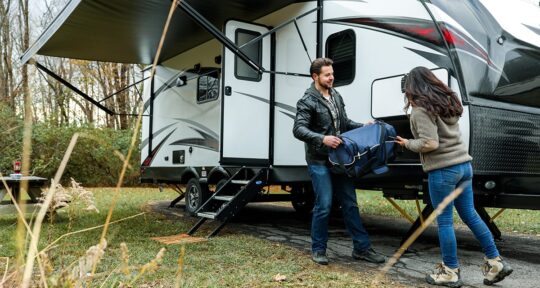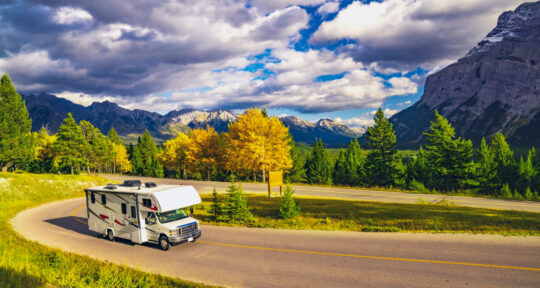It’s just past midnight. I’m sunburned, dusty, and mostly drunk. And I am standing in the middle of a pumice pit in Chemult, Oregon, surrounded by absolute mayhem. I take a slow survey of my surroundings. My bourbon sloshes, as I sip it straight from the bottle. Random headlights pierce the warm air from all directions, illuminating—in bright, ghostly strips—the cloud of fine powder that surrounds me. From every direction, the night echoes with a clash of thumping bass and wailing guitars accented by errant screams, throttling engines, and neon lights. I take a deep breath and cough. A sinking feeling overcomes me. It’s not the dehydration, the airborne filth, or the throbbing racket that overwhelms me. It’s a question that’s plaguing me instead. Has the Gambler 500 just jumped the shark? Don’t get me wrong; it’s not the orgy of pandemonium that is the Gambler 500 campsite that has me scratching my head. It’s everything preceding and following it that have me wondering if the world’s largest road rally has lost its way. Let me explain.
Original Gambler
Just five years ago, in 2014, a group of friends in Oregon organized the first Gambler 500. Their aims were simple; they wanted to see just how far off road they could drive a $500 car—what abuses a cheap car could withstand. The first few years saw tens of participants. By 2017, however, involvement in the Gambler 500 ballooned to hundreds. The now-infamous event had expanded to cities all over the U.S. as well. By its fourth year, the mission was more than to simply modify and prep cheap, crappy cars for a 48-hour off-road torture test; it encompassed stewardship of public lands and picking up trash—leave trails nicer than you found them. Each year, Gambler 500 organizers planned starting and ending rally points for the event. At the outset, at the Saturday morning starting rendezvous in Portland, they handed out rally routes in the form of detailed GPS coordinates that participants would blindly and hurriedly follow. In the middle, organizers planned camping accommodations in eastern Oregon for which they charged admission—usually around $40 per head. And, for the end of the event, they again secured a meetup location back in Portland, which featured entertainment. Although things were decidedly wilder by the fourth Gambler 500 than the previous years, there was a semblance of order and purpose. 2018 changed all of that. Its size ballooned. By its fifth year, Gambler 500 had grown to, according to its organizers, the largest road rally in the world.
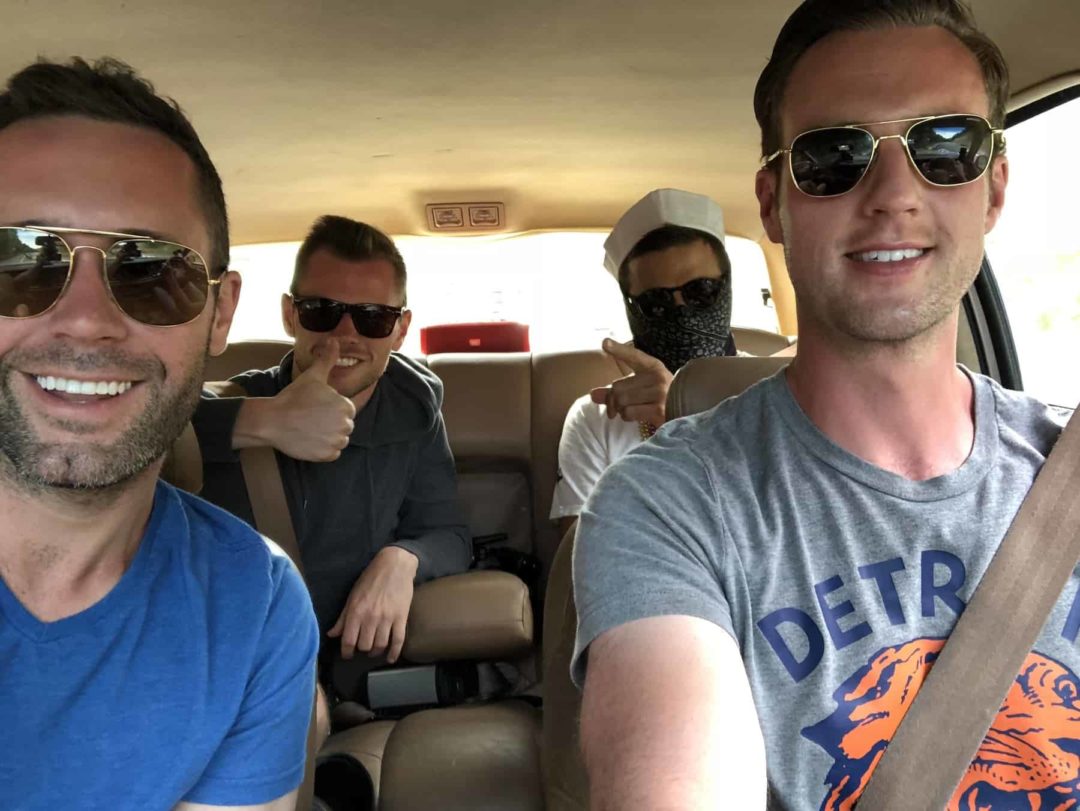
The team
My 2018 Gambler team was nearly the same as the 2017 event. I teamed up with my best friend Davis and my friend from high-school, Joel. The newest addition to the team for 2018 was Davis’ friend Baron. Davis is six-foot-three with short-cropped hair and the chin of a superhero. If you were to cast a gay Indiana Jones, you’d pick Davis. More than ruggedly good looking, Davis is the yin to my yang. When I am cantankerous, cranky, and impulsive, he’s warm-hearted, gregarious, and level-headed. Along those lines, when I am willing to lie in the dirt and get my forearms dirty working on a car, he’s not. That said, we have similar comfort levels and visions for an ideal adventure. We complement each other nicely. Joel, who was a last-minute addition to our 2017 Gambler team, is the consummate frat boy. He is about five-foot-ten with dark, short hair. He always has a mischievous grin and glint in his eye. But you wouldn’t be able to tell, because he wore a bandana over his face and a hat and glasses. In contrast to his bank-robber head gear, throughout both 2017 and 2018 Gambler 500 events, Joel wore a neon-pink Hawaiian shirt and Seerscuker shorts. I see Joel as our mascot. During the 2017 Gambler, he sat on top of our car drinking beer and shouting at passersby. When it comes to Gambler planning, Joel thinks solely about flare, rather than mechanics or logistics. Especially on the Gambler, Joel plays the role of the devil sitting on your shoulder. Whatever the most ridiculous thing you can think of in any given moment, Joel not only endorses it, he embodies it. Going into 2018 Gambler 500, I didn’t know Baron. On the road, I found he kept us a bit grounded. He was definitely the most reserved of the group, which was probably a good thing. I don’t know if there was enough room inside our car for a fourth oversized ego—and we had quite a big car.The vehicle the four of us landed on for 2018 Gambler 500 was a $600 1995 Lincoln Town Car. We named it Gale after the man who penned the Town Car’s design, Gale Halderman. After countless hours of online debates and three decided-upon—then scrapped—themes, we painted Gale purple and gold and secured a fake longhorn bull skull to the hood. We installed a five-inch suspension lift kit and bolted up 29-inch mud tires. And we topped Gale off with a roof basket, which held our gargantuan Bluetooth speaker and a spare tire. With that, we were ready for the road.
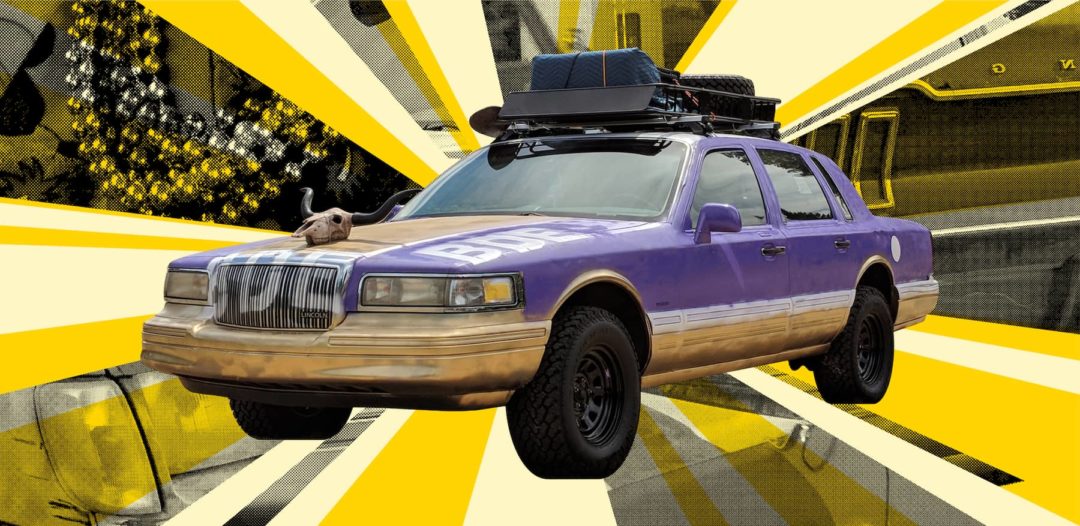
Furious discovery
Eight weeks before the Gambler 500, my teammates and I discovered the plan—or lack thereof—for the 2018 event. We were dismayed. Davis, my co-team leader, was so taken aback by the realization that he didn’t believe it at first. He insisted that I didn’t read the website right—that I had misunderstood the official plan. To our chagrin, the more we read on the official Gambler blog, which detailed the 2018 plans, the more reality set in: For 2018, there would be no Saturday morning rally point route and no route coordinates; there would only be an organized campsite. Davis, along with the our other teammates, Joel and Baron, eventually took the news in stride. I, on the other hand, was livid—and for good reason.
For an entire year, Davis and I had been champing at the bit to get back out on the trail for the Gambler. It was the one escape we were afforded from our normal lives. It was the singular week each year we had the chance to mistreat a car, act like imbeciles, drive like silly, and rub elbows with fringe hooligan-types. And part of it, the whole mass-camaraderie part of the adventure, had just been yanked away from us.
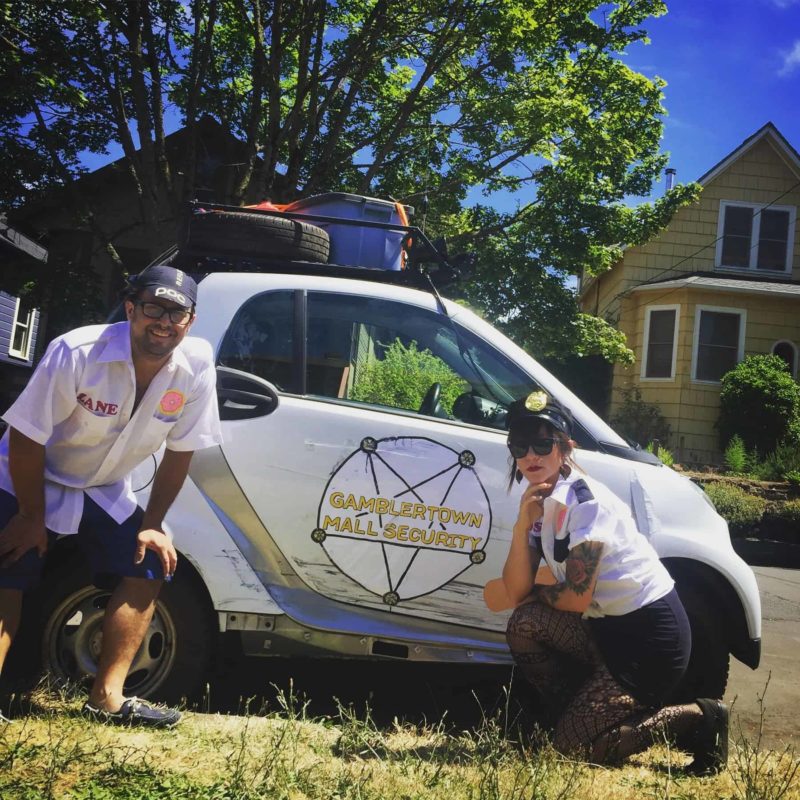
While I wanted insane hijinx, Davis desired group camaraderie. He longed to slowly parade through the forest with a bunch of other silly cars. Without any pre-planned routes for all participants to follow, I feared we’d wind up following some numbskull through the forest for a couple days and thereby miss out on any real hair-raising adventure.
That in mind, I argued our small caravan of cars go our own way. Davis was adamant that we could find someone with a route—one that surely most other wayward Gambler attendees would follow. So, I encouraged him to search the Gambler 500 forum and find one.
He never did. So, we winged it.
We drove in convoy with two other high school friends of mine, Zane and Ashley, who piloted a lifted Smart Fortwo. Zane’s girlfriend and a few other comrades followed them in a $200 Ford Explorer. Zane bought the Explorer for the 2017 Gambler. After the event was over, the Explorer became a daily driver. However, it was brought out of retirement for Gambler duties once more.
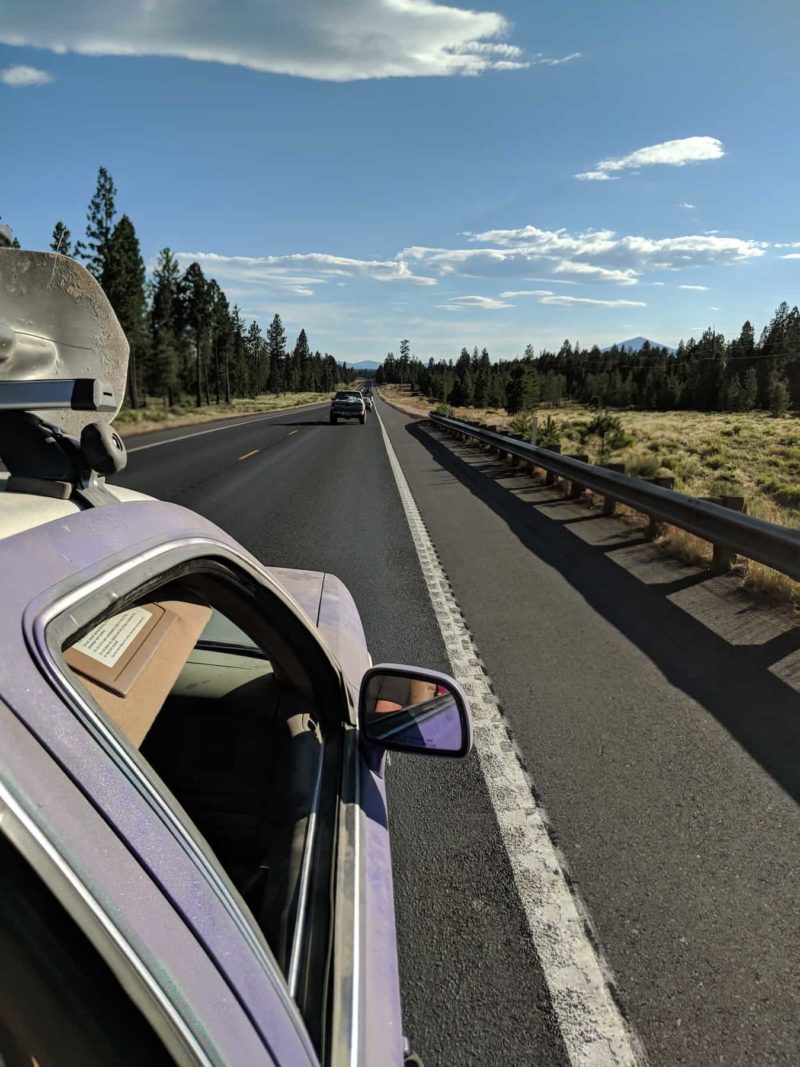
Winging it
“I’m going to shoot it. I am going to shoot it off,” Joel slurred, as he drunkenly grasped the vintage, rusty chrome 22-caliber revolver in his right hand. “Stand back. I’ll get that jack free.”
Joel slowly wobbled in place, with his arms extended in front of him and his left eye squeezed shut. His balance was wrecked. He’d been pounding beers since dawn.
“Is he—is he really going to shoot it?” Davis asked in a shocked, frightened tone.
“God, I hope not,” I said, as I ducked behind a tree. Davis dropped to his belly in the sand. Just behind him, I could see Baron crouched behind a tiny 36-inch pine sapling.
“Baron, when that bullet ricochets, that twig won’t do anything to protect you,” I shouted.
Pop! Pop! Pop!
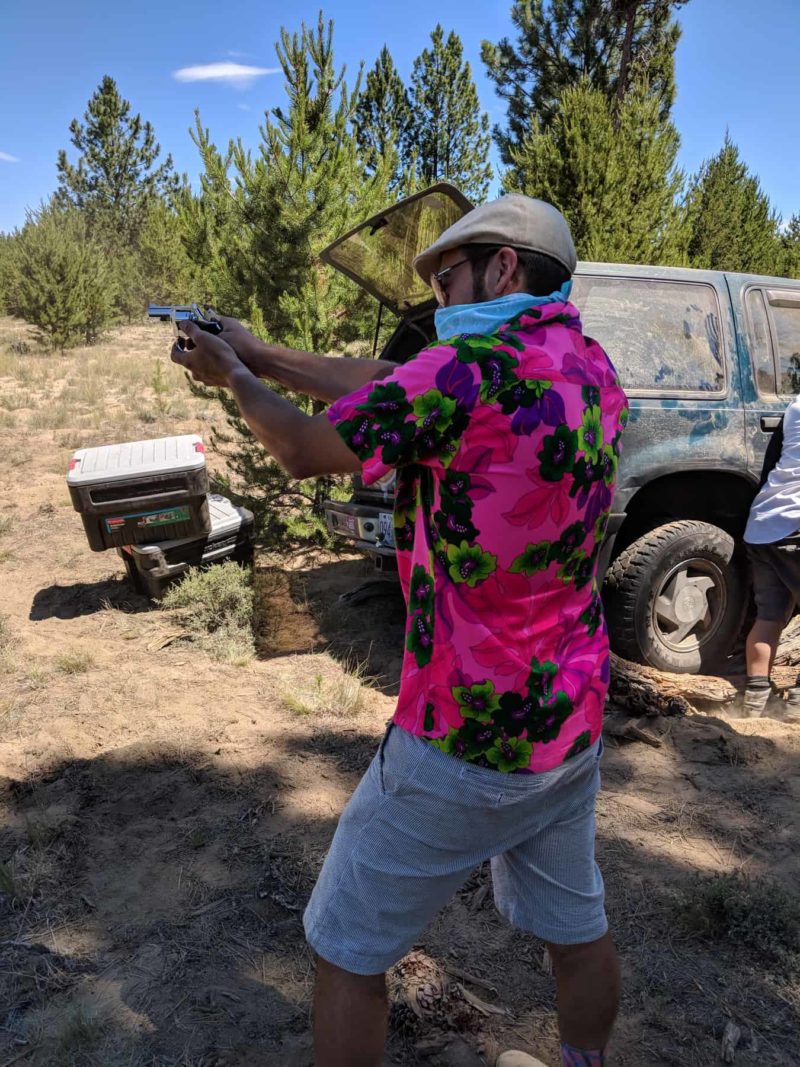
“I can’t believe it fired—and didn’t blow off your hand!” Zane cackled.
Turns out, Zane had acquired the little rusty chrome revolver at an old lady’s estate sale. He discovered it in a wooden chest in between two blankets. It was cocked and loaded inside a plastic bag. He got it, and a handful of other knickknacks, for $20. And he wore it on his hip for the Gambler just as a joke.
Thankfully, at the last second, Joel decided not to aim for the bright red jack wedged in the soft sand beneath the dented dark green Ford Explorer. Instead, he fired aimlessly into a line of thin pine trees.
This is what happens when you wing it.
Without any GPS coordinates to follow from the Gambler 500 organizers, we had blazed our own trail. Out off of Oregon Highway 22, en route to Derrick Cave, we daringly took a random left into the woods. 500 yards down an ever-narrowing trail, the woods suddenly opened up, revealing a big clearing. With no clear trail to follow, we stopped to regroup and figure out our next move.
That’s when the vehicles—the Ford Explorer, Zane’s Smart Fortwo, and our Lincoln Town Car—sank into the sand.
The harder we fought to get the cars out, the deeper they melted into the earth.
Thanks to its relative light weight, the Smart was easy to free from the sand. I slowly dug the Town Car out. The Explorer, though, took more coaxing.
We dug out deep holes beneath the Explorer’s rear tires. We then filled the holes with fallen branches, hoping it’d give the old, bald tires enough momentary traction to free itself from the sand. The friction of the spinning tire against the dry branches nearly started a fire. Gray smoke wafted from the hole.
So, we pulled out the big hi-lift jack. It got stuck, too. Almost as if we’d planned it, the jack held enough of the Explorer’s weight to become immovable while also sinking far enough into the sand that it no longer effectively lifted the green SUV. That’s when Joel grabbed the gun off Zane’s hip and decided to drunkenly cowboy the jack loose.
Although we eventually freed ourselves from the high-desert sand, spelunked in the Derrick Cave, and swam in East Lake, getting lost and woefully stuck for several hours was the highlight of the afternoon—and the 2018 Gambler 500—for me.
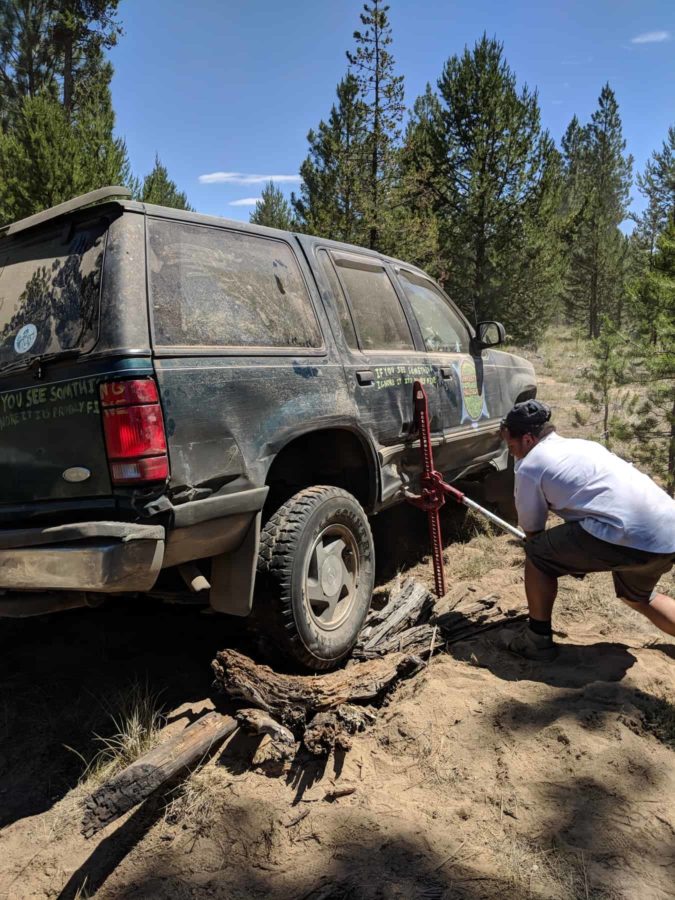
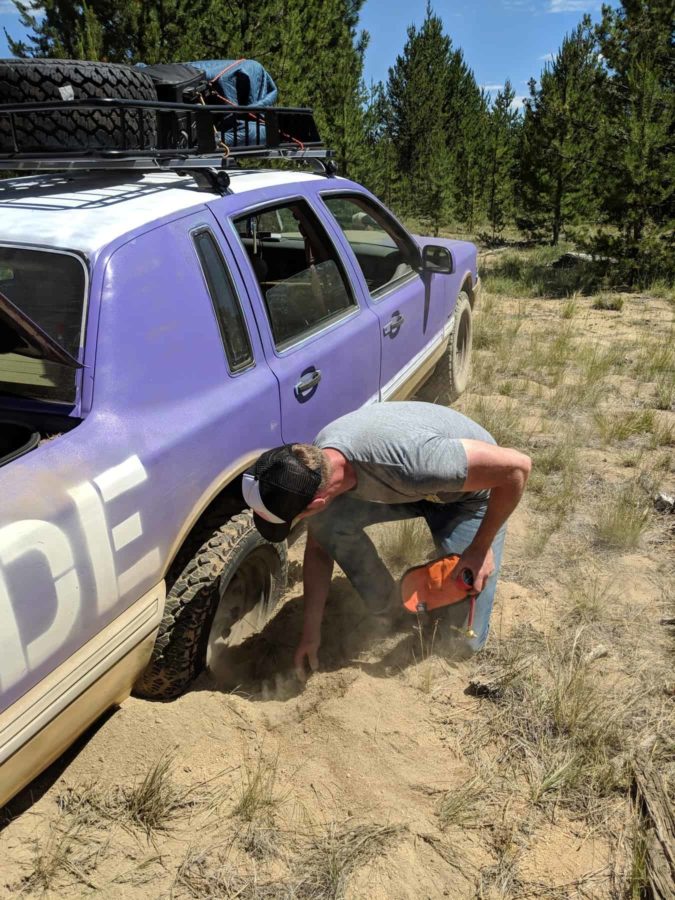
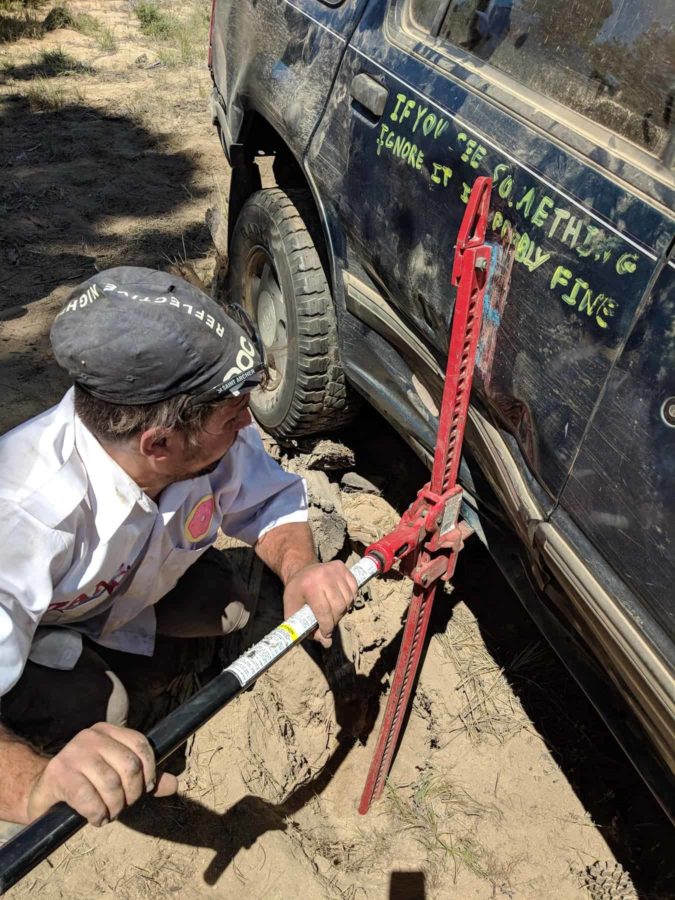
Camp Gambler
We arrived at the Saturday night campsite, the pumice pit in Chemult, Oregon, right as the sun set. We paid our $42 per head and slowly drove in, looking for a place to camp out for the night. We passed all sorts of wild machines: A Corvette that appeared like it’d been stripped for parts, a boat with wheels, and a lifted 1970s limousine.
We circled our wagons as best we could, to avoid being run over by drunkards during the night, and pitched our tents in the middle. With our stuff laid out, and our cars resting for the night, we cracked open our booze and toured the camp. We slowly wandered the pit, taking it all in.
THE SCENE REMINDED ME OF BURNING MAN, IF IT WERE HOSTED BY THE HELLS ANGELS AND ATTENDED EXCLUSIVELY BY 17TH-CENTURY PIRATES.
Shirtless middle-aged men with grime-dusted beards rode by on mini dirt bikes. Equally grimey women undulated tentside to the rhythmic tunes that poured out of their cars’ speaker systems. Others, like us, just milled around, quietly absorbing the bedlam.
The scene reminded me of Burning Man, if it were hosted by the Hells Angels and attended exclusively by 17th-century pirates.
The scene was otherworldly to me. Save “no fireworks” and “don’t be a dick,” the camp had no rules. It felt like the kind of event that you might stumble upon one hundred years from now, after western civilization as we know it collapses and only outlaws use gasoline.
“Finally, an event not run by the damned libs!” I heard a gruff voice proclaim from somewhere in the dusky evening.

Trailer queens
Although I initially asked myself the night before whether the Gambler 500 jumped the shark, it was the next morning’s scene that underlined that question.
Standing in front of the open Town Car trunk, I brushed my teeth and watched dust-covered Gamblers dizzily stir to life. It was like a scene from a zombie movie, as filth-covered people rose to their feet and stumbled around their campsites. Eventually, they began to pack up and drive off, exiting the makeshift camp.
I watched in dismay as many of my fellow Gambler 500 hooligans loaded their post-apocalyptic rigs—that they had so proudly paraded around the camp the night before—onto trailers hitched to full-size luxury pickups. Just six hours previous, these same ruffians partied as if the world had ended. Now, they were towing their “$500 vehicles” with trucks worth more than the average American’s annual income.
And that’s when I really, honestly asked myself the question.
Is the Gambler 500 as we know it over?
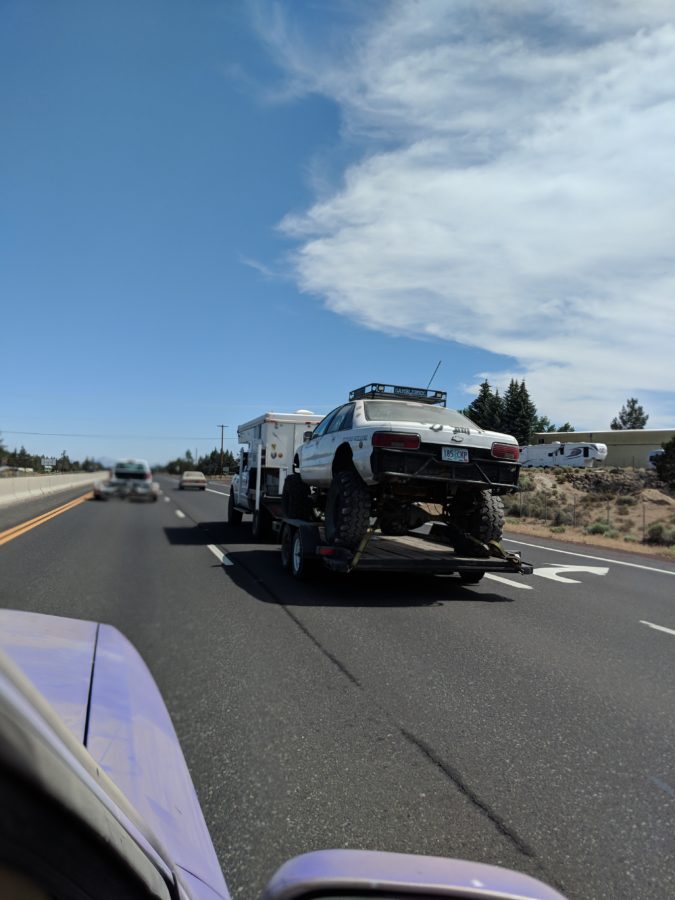
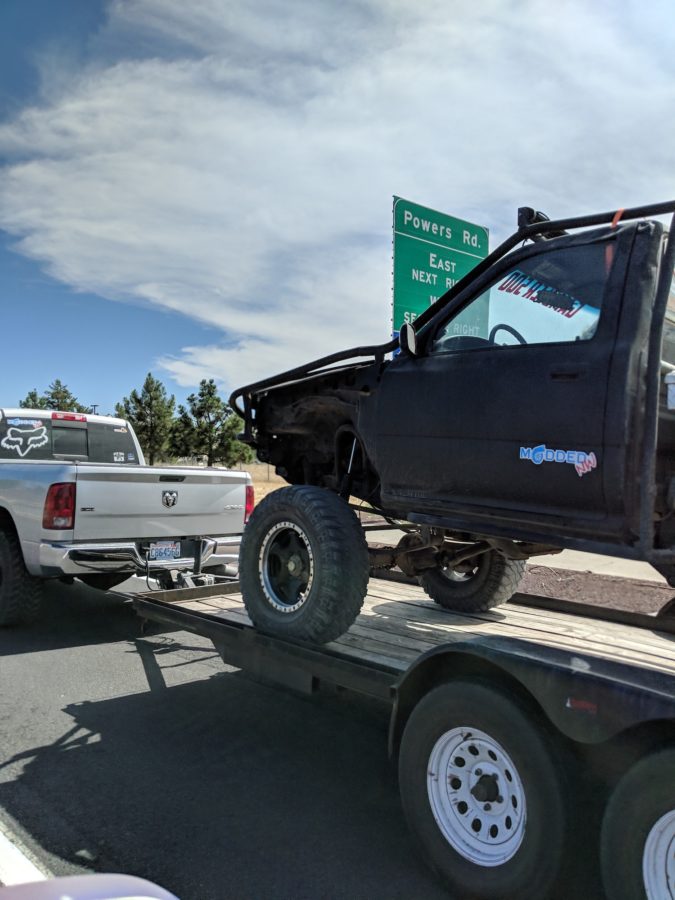
The organizers no longer planned much of anything, other than finding a fenced-in area large enough to accommodate the thousands of attendees. Without coordinated GPS routes, we participants no longer rallied and paraded together along dusty fire roads, as we had in years past. And many Gamblers, it seemed, didn’t even put their wild vehicles to the test—the whole reason the event was founded in the first place. Rather, they treated them like trailer queens.
Has the Gambler 500 devolved into just a reason for the founders to sell swag and for participants to trailer post-apocalypse-worthy vehicles to the desert for a drunken rager?
Posts on the official Gambler 500 Facebook page seemed to answer my question without directly answering it. Not long after the 2018 Gambler 500 concluded, founder Tate Morgan crafted a post on the Facebook page encouraging people to do their own thing—like he had in 2014.
Maybe that’s the answer to the question: Forget what Gambler has become and focus on what it will be in the future. Perhaps splitting the Gambler into one thousand micro Gamblers organized by and for a small group of friends is the best, most authentic way forward.
No matter what, Davis, Joel, Baron, and I will be back out on the trails next summer driving something ridiculous.
